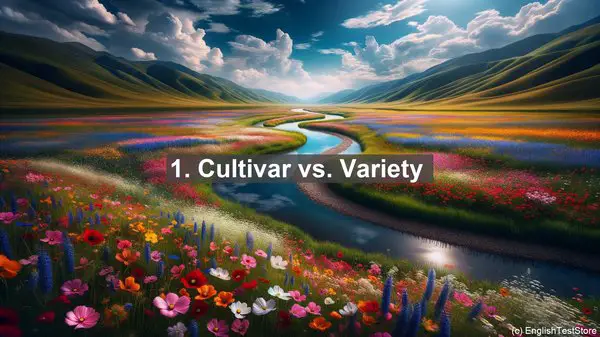Introduction
Today, we’ll be diving into the world of ethnobotany, a captivating field that explores the relationship between plants and people. As you delve deeper into this subject, you’ll come across several words that may seem similar but have distinct meanings. In this lesson, we’ll unravel the top 10 commonly confused words in ethnobotany, ensuring you have a solid grasp on their nuances.
1. Cultivar vs. Variety
When discussing plant classification, the terms ‘cultivar’ and ‘variety’ often arise. While they both refer to distinct groups within a species, the key difference lies in how they’re maintained. A cultivar is a cultivated variety, meaning it’s deliberately bred and maintained by humans. On the other hand, a variety can occur naturally or be bred, but it’s not actively maintained. So, think of cultivars as the result of intentional human intervention, while varieties can arise spontaneously or through selective breeding.
2. Decoction vs. Infusion
In the realm of herbal preparations, ‘decoction’ and ‘infusion’ are two common methods. A decoction involves boiling plant material, such as roots or barks, in water for an extended period. This method is ideal for extracting compounds that are less soluble. In contrast, an infusion is created by steeping plant parts, like leaves or flowers, in hot water for a shorter duration. This method is suitable for extracting more delicate compounds. So, the choice between a decoction or an infusion depends on the desired constituents and their solubility.
3. Indigenous vs. Endemic
When discussing plant distribution, ‘indigenous’ and ‘endemic’ are often used. ‘Indigenous’ refers to a plant species that is native to a particular region, meaning it has been growing there for a long time. On the other hand, ‘endemic’ species are even more restricted. They are not only native to a specific area but are found nowhere else in the world. So, while all endemics are indigenous, not all indigenous species are endemic.

4. Ethnobotany vs. Ethnopharmacology
Ethnobotany and ethnopharmacology are two interdisciplinary fields that explore the relationship between plants and people. While they share similarities, they have distinct focuses. Ethnobotany examines the traditional knowledge and uses of plants by different cultures, encompassing not just medicinal aspects but also food, materials, and rituals. Ethnopharmacology, on the other hand, specifically investigates the medicinal properties of plants used by indigenous communities. So, while ethnobotany is broader in scope, ethnopharmacology is more specialized.
5. Tincture vs. Extract
In herbal medicine, ‘tincture’ and ‘extract’ are often used interchangeably, but they have subtle differences. A tincture is created by soaking plant material, usually in alcohol, to extract its active compounds. On the other hand, an extract can be obtained using various solvents, not just alcohol. Additionally, tinctures often preserve the plant’s natural ratio of constituents, while extracts can be standardized to contain specific amounts of active compounds. So, tinctures are more traditional, while extracts offer more control over the concentration of desired constituents.
6. Contraindication vs. Side Effect
When considering the safety of herbal remedies, it’s important to understand the difference between ‘contraindications’ and ‘side effects.’ A contraindication refers to a situation where a particular herb or remedy should not be used due to potential harm or interactions with other medications. On the other hand, a side effect is an unintended, often undesirable, outcome that can occur even when the herb is used appropriately. So, while contraindications are absolute reasons to avoid a remedy, side effects can be managed or minimized.

7. Exotic vs. Invasive
In the context of plant species, ‘exotic’ and ‘invasive’ are terms used to describe non-native plants. An exotic species is simply a plant that is not native to a particular region. It may have been introduced intentionally or accidentally. However, not all exotic species become invasive. An invasive species is one that not only establishes itself in a new area but also has a negative impact on the local ecosystem, often outcompeting native plants. So, while all invasive species are exotic, not all exotic species are invasive.
8. Macropropagation vs. Micropropagation
When it comes to plant propagation, ‘macropropagation’ and ‘micropropagation’ are two techniques. Macropropagation involves using whole plant parts, such as stems or roots, to create new plants. This method is often used for larger plants and is relatively simple. Micropropagation, on the other hand, is a more advanced technique that involves using tiny plant parts, like meristematic tissues, to produce numerous plants in a laboratory setting. This method is particularly useful for rare or valuable species. So, the choice between macropropagation and micropropagation depends on the plant species and the desired scale of propagation.
9. Phytoremediation vs. Phytomining
Both ‘phytoremediation’ and ‘phytomining’ are plant-based approaches used in environmental remediation. Phytoremediation involves using plants to remove, degrade, or contain pollutants in the soil, water, or air. It’s a sustainable and cost-effective method. Phytomining, on the other hand, is a technique where plants are grown in metal-rich soils. These plants absorb the metals, and when harvested, they can be processed to extract valuable metals. So, while phytoremediation focuses on environmental cleanup, phytomining combines environmental remediation with resource recovery.
10. Botanical Name vs. Common Name
When referring to plants, it’s essential to be familiar with both their botanical names and common names. The botanical name, often in Latin, is a standardized, globally recognized name that ensures clarity and accuracy. Common names, on the other hand, can vary regionally or even locally, leading to confusion. While common names are more accessible and relatable, they can be imprecise. So, when communicating about plants, it’s best to use the botanical name, supplemented with the common name for better understanding.
